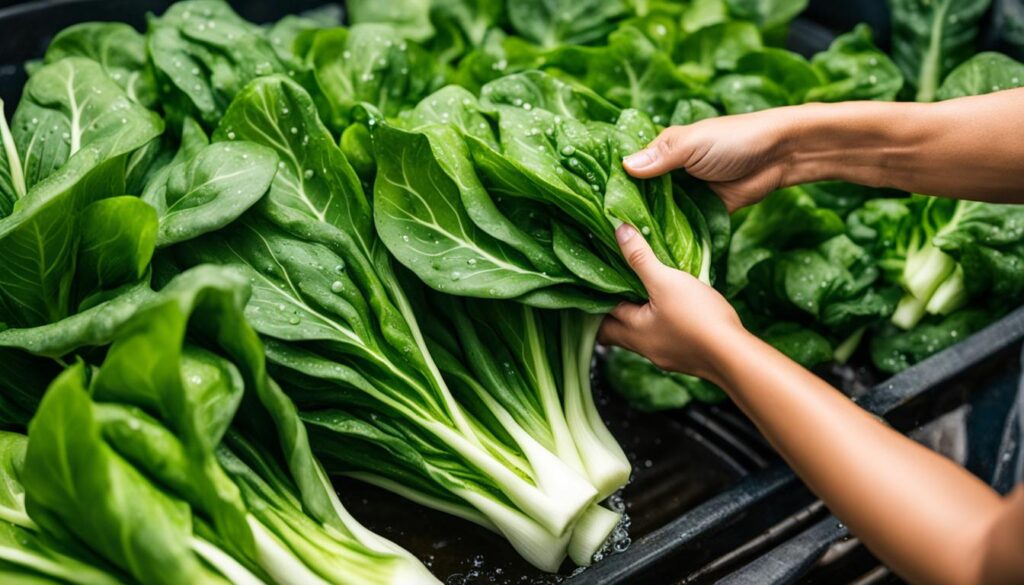Welcome to our comprehensive guide on how to clean bok choy. Bok choy is a nutritious and versatile vegetable that can add a refreshing crunch to your dishes. But before you can enjoy its flavors, it’s important to ensure that your bok choy is clean and free from any dirt or grit.
Cleaning bok choy is a simple process that starts with removing the base of the vegetable, which often contains dirt. By following a few easy steps, you can have clean bok choy ready to be used in your favorite recipes. Let’s dive right in and discover the best way to clean this leafy green.
To begin, chop off the base of the bok choy. This tough and fibrous part can contain dirt and should be discarded. Once the base is removed, separate the stalks of the bok choy and place them in a bowl.
Cover the bok choy with cold water and swish it around to loosen any dirt. This will help remove any lingering particles that may be on the leaves. Let the bok choy sit in the water for about 10 minutes, allowing the dirt to settle at the bottom.
After the soaking time, lift the bok choy out of the water and place it in a strainer to remove excess moisture. You can gently shake the strainer to help remove the water. Finally, pat the bok choy dry with paper towels or a clean kitchen towel before using it in your recipes.
By properly cleaning your bok choy, you can ensure that it is fresh, safe, and ready to be enjoyed in any dish you desire. In the next section, we will explore the proper way to cut bok choy to maximize its culinary potential.
How to Cut Bok Choy
When it comes to preparing bok choy, knowing how to cut it properly is essential to ensure even cooking and a pleasant eating experience. Follow these step-by-step instructions to master the art of cutting bok choy:
- Cut the bok choy in half lengthwise: Begin by placing the bok choy on a cutting board and carefully cutting it in half lengthwise. This will create two equal halves that will be easier to manage.
- Remove the core: Locate the core of each bok choy half, which is the thick, white section at the base of the vegetable. To remove it, make a diagonal cut along the core, creating a triangular shape that you can discard. This step will help to prevent any bitterness in your dish.
- Cut the stalks: Take each bok choy half and cut the stalks crosswise into small, bite-sized pieces. This will create evenly-sized portions that will cook more uniformly.
- Cut the leaves: Moving on to the leaves, start by cutting them lengthwise and then crosswise into bite-sized pieces. This will give your dish a nice mix of textures.
Now that you’ve successfully chopped the bok choy, it’s important to clean it properly before using it in your recipes. Rinse the chopped bok choy under cold running water to remove any dirt or grit. To remove excess moisture, you can either drain the chopped bok choy on a clean dish towel or use a salad spinner. This will ensure that your bok choy is free from any unwanted debris.
How to Store Bok Choy
After cleaning and using the necessary amount of bok choy, you can store the leftover bok choy in a plastic bag in the refrigerator. Make sure the bok choy is dry before storing it to prevent wilting and sliminess. Keep the bok choy stored with other vegetables in the produce drawer of the refrigerator. Properly stored bok choy can stay fresh for 5 to 7 days.
Conclusion
Cleaning and cutting bok choy is a crucial step in preparing this versatile vegetable. Follow these simple steps to ensure that your bok choy is clean and ready for use in a wide range of recipes. Start by discarding the tough base and separating the stalks. Then, thoroughly wash the bok choy to remove any dirt or debris. Whether you choose to cut it into small pieces or leave it intact depends on the specific needs of your recipe. Lastly, store any leftover bok choy properly to maintain its freshness and quality. Enjoy the delicious flavors and health benefits of bok choy in your cooking!
To clean bok choy, begin by removing the base, which may contain dirt. Afterward, separate the stalks and place them in a bowl. Swish the bok choy in cold water to loosen any dirt, allowing it to settle at the bottom. Lift the bok choy out of the water and strain off excess moisture. Pat dry before using. When it comes to cutting bok choy, start by halving it lengthwise and removing the core. Chop the stalks into small pieces and the leaves into bite-sized portions. Rinse the chopped bok choy under cold water to remove any remaining dirt and drain it well. Proper storage is key. Store leftover bok choy in a plastic bag in the refrigerator, ensuring it is dry to prevent wilting.
By diligently following these cleaning and cutting tips, you can confidently prepare bok choy for cooking. Its crisp texture and mild flavor make it a versatile ingredient in stir-fries, salads, soups, and more. Remember to adjust the cleaning and cutting techniques based on your preferred recipe. Now that you’re equipped with the knowledge of how to clean, cut, and store bok choy, you can embark on a culinary adventure and delight in the exceptional taste of this delightful vegetable. Happy cooking!
Can Bok Choy Cleaning Methods Help Kill Roots in Sewer Line?
Yes, proper bok choy cleaning methods can potentially help with sewer line root removal techniques. The high water content and natural enzymes in bok choy could assist in breaking down and killing roots in the sewer line. It’s worth exploring as a natural alternative to harsh chemicals.










